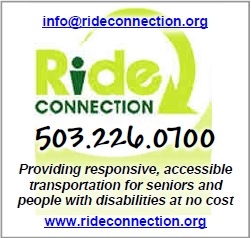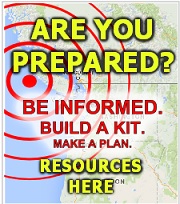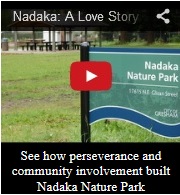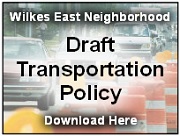Download the Wilkes East Neighborhood Fall 2025 Newsletter here!
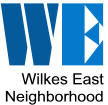
|
Fall 2025 Newsletter"Diversity, Harmony, Community - |
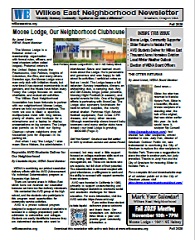
|
Fall 2025 NewsletterInside This Issue:
|
Download your copy here. (includes active web links)
¡Descargue nuestro boletín en español aquí!. (incluye enlaces web activos)
Newsletters are a regular publication of the Wilkes East Neighborhood Association. They are hand-delivered to over 1,500 residences and businesses in our area 3 times per year, timed to correspond with our general meetings.
View archive | Policy & Ad Rates
|
Got a story or tip to share? |
|
Volunteers Needed |
The Thousand Acres Homeless Camp Eviction

By Janet Unruh, WENA Board Member
Until recently, several dozen homeless campers were living in a forested area northeast of Troutdale on the Sandy River Delta, a.k.a. Thousand Acres Park. The park is about three miles from Gresham and five miles from the Wilkes East neighborhood. It consists of 50 acres of land owned by the Oregon Department of State Lands (DSL), next to 1,500 acres owned by the U.S. Forest Service. The campers have been living on the DSL land[1]. There have been an estimated 35 camps, some of which were in existence for nearly 25 years[2]. DSL states that the land is not suitable for habitation because of wildfire risk, flooding, and environmental degradation[3].
For these reasons, the state attempted a brute-force eviction of the campers in June, but it failed because the campers and their supporters fought back. Another eviction by means of persuasion and facilitation has been underway since then, with a deadline of October 1st to leave voluntarily, after which the remaining campers were to be forced out. There are unanswered questions about where the campers have gone.
THE CAMPS
Campers said they worked to keep their sites clean and used restrooms at nearby parks[4]. They had electricity—the camps had multiple generators and electrical lines that ran from camp to camp[5]. We have meetings—we try to have standards," said Gene, one of the longtime campers. Gene's camp was visibly tidy, complete with decorations and a makeshift fence[1]. However, when the local TV station, KGW, visited the site, most of the camps they saw were not like his[4].
Many living in Thousand Acres describe their community as a family. “This community is a very rare one indeed. It’s a community that’s full of people that come from different walks of life, that in a normal setting would not get along. But one thing that we appreciate the most [about] Thousand Acres is it’s always been a place where we could go and feel like no one is here to judge[4]. Another said, "This is more of a communal existence out here[1].”
The area has multiple memorials for community members who have passed, and gravesites for deceased pets. But in spite of their efforts, trash accumulated and the area became polluted, especially around abandoned camps.
THE INITIAL EVICTION ATTEMPT
Notices were posted in May, stating that campers had to leave by June 2[6]. Campers were to be forced out after the deadline[2]. They hadn’t been offered any help, they said[7].
On June 3, teams from two contract companies hired by DSL, NorthWest HazMat, Inc., and Northwest Enforcement Inc., arrived at Thousand Acres with work crews, trucks, and an excavator. They were blocked at the site by ditches dug across the road to the camps and barriers erected to prevent eviction[1]. A crowd of campers and their supporters had gathered to resist the eviction and cleanup effort. They held up signs that said, “We do not consent” and “Stop the sweep.” As the contractors began attempting to collect the belongings of the campers, a struggle ensued, and witnesses said that four people were maced by the hazmat workers[4]. Oregon Governor Tina Kotek ordered a pause on the eviction due to the repeated clashes[7]. The contractors had been on site for less than a week.
WHAT’S HAPPENING NOW
The Department of State Lands (DSL) reassessed its approach and worked with homeless advocates to determine the best way forward. DSL hired remediation contractor Rapid Response Bio-Clean, which is experienced in trauma-informed engagement and field operations[8].
Multnomah County Homeless Services Department (HSD) contracted with The Salvation Army to conduct outreach to the campers throughout the summer and fall. The outreach team made regular visits to the camps to build trust, share information, and offer connections to shelter and services[3].
"We do anticipate that this current effort will be ongoing for the next several weeks," said DSL spokesperson Alyssa Rash. "Our priority at this time remains voluntary compliance with the people experiencing homelessness or camping overnight at the Delta to relocate. However, we are partnered with law enforcement agencies, and when we have exhausted every avenue toward voluntary compliance, we do have enforcement as a legal backstop option[9]."
The campers responded by submitting a proposal, the “Cooperative Stewardship Proposal for the Sandy River Delta,” which would allow them to continue to live on site and help maintain the space[4].
“This proposal presents a community-driven approach to managing the Sandy River Delta. It emphasizes environmental restoration, responsible habitation, and proactive land management—all aimed at preserving human dignity while safeguarding ecological balance. By integrating sustainable housing solutions with organized land cleanup and long-term cooperative governance, this model stands as a robust alternative to short-term, temporary fixes that have failed many in our community[10].”
The proposal offered solutions for abandoned camps, waste management, hazardous waste, fire safety, enforcement of community rules, unauthorized vehicles, and land restoration. The proposal included a description of the supporting legal and financial framework. The proposal requested modular tiny homes and sustainable infrastructure, with estimated costs of approximately $11,357 – $14,957 per unit. No estimate was given for the number of units. The proposed timeline for phase one called for cleanup and restoration to be completed by August 25. Remaining activities were listed, but without dates.
In conclusion, the proposal offered “a permanent, sustainable solution for the Sandy River Delta. By addressing immediate cleanup needs and combining cost-effective, modular housing with robust community governance, we move beyond the short-term fixes that have repeatedly failed our community. This unified model not only ensures dignified, long-term shelter but also fosters a resilient system of environmental and community stewardship[10].”
The proposal was apparently ignored by DSL. Perhaps the biggest reason would be the risk of flooding. If we ever have another flood like the one in 1996, it would wipe out their village.
THE OCTOBER EVICTION
Some campers had moved out of Thousand Acres by September. On September 15, DSL announced a new, accelerated phase in the eviction and cleanup process. Legal notices were posted at the remaining occupied camps on September 26 informing residents that the area would be closed on October 1st—five days later—and they had to vacate immediately[3].
HSD’s contract with The Salvation Army expires at the end of October, and the outreach team will continue to work with the remaining campers until then. DSL’s contractor, Rapid Response Bio-Clean, will remove personal property and debris from the site, and a (unnamed) security contractor will monitor the area to prevent campers from returning. The area will remain closed for restoration until January 2026[3].
THE OUTCOME FOR CAMPERS
Did East Multnomah County (or the metro area generally) have the capacity to house several dozen homeless people by the October 1st deadline? How many were placed in housing, and how many were forced out to the streets or parts unknown?
I interviewed The Salvation Army Program Manager Phillip Emery about their effort to help the campers transition to shelter. He assured me that they all had access to resources, including the Salvation Army’s own shelters, but he explained that it was out of scope to ensure that everyone was placed. At the end of October, HSD would take that over[11].
The HSD’s data dashboard is a monthly view of data about homelessness in Multnomah County. The most recent demographics as of July, 2025, show 8,278 chronically homeless people in Multnomah County, with 4,467 unsheltered[12].
“I’m on a six-month waiting list for housing, and I don’t know what I’m going to do,” a 20-year Thousand Acres resident known as Grizzly said in the group’s press release. “There’s gotta be some kind of a solution that’s not forcing us out and putting us in jail. That would help nothing[4].”
"There's 40 of us that aren't willing to separate. So as a family, we are going to find a neighborhood somewhere where we can exist at. That may be in somebody's backyard. It may be on their front (expletive) porch," Thousand Acres resident, Countryman said. "I'm not real happy about any of this, but we have to be somewhere[2].
ADDENDUM
I contacted Zach Kearl, Management Analyst at Multnomah County’s Homeless Services Department, to ask him to comment on a draft of the article I wrote on the Thousand Acres homeless camp eviction. He and I have discussed the homeless situation many times over the past months. He kindly wrote back to me in email on October 20, 2025 and told me several interesting things. He gave me his permission to post his response on the WENA newsletter website:
Hi Janet,
Sorry that we missed your deadline of Friday last week. I was out for a good chunk of the week and was playing catch up with the few days that I had.
I have a few notes to offer up after reading your article:
The attempted campsite removal in June was paused in large part because of issues with DSL's contracted provider doing the clean up and insufficient planning to manage protests. The significant differences this go around were that DSL coordinated with Oregon State Police to provide crowd management and assist in trespassing, as well as contracting with a more experienced campsite removal org used by City of Portland and ODOT. In both instances, there were considerable attempts at connecting individuals living in Thousand Acres to services and available shelter or housing.
Many of the folks who were living in Thousand Acres are not interested in shelter or conventional housing. Some have aspirations of creating a commune and have since tried to relocate to other undeveloped land in the surrounding areas to do so, including USFS and ODOT properties. Sustained enforcement across the multi-jurisdictional areas are being planned.
The planned posting for October removal was communicated with residents of Thousand Acres up to a month in advance, with The Salvation Army outreach team and Rapid Response Bioclean visiting campsites and talking with residents on a daily basis. The official posting was merely an obligatory legal step prior to being able to proceed with enforcement.
At the last update from DSL and Rapid Response I attended (last week), teams reported that after some attempts to resettle after the initial enforcement, DSL has successfully closed the Thousand Acres area and Rapid Response is underway removing material as planned. Personal possessions are being stored for up to a month, per Oregon Revised Statute (ORS), and will be returned to property owners if requested.
There were about a half dozen individuals who accepted a shelter bed around the week of enforcement. Those that did, ended up in one of the region's alternative, village-style shelters.
Outreach teams have sought to enter folks into HMIS to support case management; however, individuals are not compelled to provide the requisite information if they are not accepting services.
I'll also share that the resident you quoted, Grizzly, was housed a couple years out of Thousand Acres. I had a chance to talk with him this Spring when I went out there. Unfortunately, he returned to homelessness. What he shared with me was that there were interpersonal challenges with the property manager and dissonance in being in a more urban/sedentary environment--just a microcosm of the obstacles that can occur when trying to end homelessness for folks who have lived outside for years and decades.
Sincerely,
Zach
Zach Kearl (he/him), MPA
Management Analyst
Homeless Services Department
Multnomah County | Gladys McCoy Building
619 NW 6th Avenue, Portland, OR 97209
Click "Read more" (below) to view Endnotes
Slider the Otter Returns to Nadaka Nature Park

|
By Janet Unruh Good news— Slider, the otter has returned to Nadaka Nature Park. Slider is a beautiful, life-size bronze sculpture of a standing otter, the twin of the original,that was stolen. As luck would have it, sculptor Rip Caswell (https://caswellsculpture.com/) had created two otter sculptures, almost identical in size. |
Judy Han, director of Gresham Outdoor Public Art, was instrumental in convincing the City of Gresham to replace the otter sculpture in Nadaka Park. There was a suggestion to place the otter in another park, but Judy prevailed. Thanks to Judy Han and the City of Gresham for restoring Slider to Nadaka Park.
For a complete list and downloadable map of all outdoor public art in the City of Gresham please visit https://www.greshamoutdoorpublicart.com/
Moose Lodge, Our Neighborhood Clubhouse
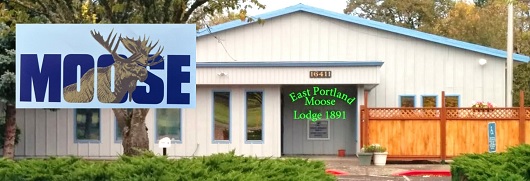
By Janet Unruh, WENA Board Member
The Moose Lodge is a fraternal order—a membership organization with formal rules, officers, and local chapters (often called lodges). Fraternal orders in the United States include the Freemasons, Odd Fellows, Knights of Columbus, the Elks, and many others. Decades ago, the Moose Lodge was a men-only club with initiation rituals, but over time it has opened membership to all genders, and the rituals have fallen away. Today the Lodge focuses on social, charitable, and mutual-aid activities.
The Wilkes East Neighborhood Association has been fortunate to partner with our neighborhood Moose Lodge, where we hold our public meetings. The room we use is ideal: a spacious, multipurpose room with long tables, plenty of chairs, and hookups for a microphone and a laptop to display presentations on big screens. The Lodge also permits us to hold our Spring Cleanup—where neighbors drop off household junk for disposal—in its parking lot.
And when I say “the Lodge,” I also mean Steve Waters, the administrator. I interviewed Steve and learned much more about the Lodge. He is personable and generous and was happy to talk about its activities; I scribbled notes as fast as I could. The Lodge keeps a full calendar: Sunday breakfasts, dinners, an art/painting club, a camping club, Boy and Girl Scouts, bingo, poker, pinochle, Monday Night Football (in season), and special events for kids. One of its biggest efforts is partnering with SnowCap. The Lodge also sponsors fundraisers for back-to-school supplies, the county animal shelter, Parkrose High School football equipment, Red Cross CPR classes, and many other causes. Although membership skews toward baby boomers—and many similar clubs have closed—our local Lodge is growing.
On the national scene, Moose International supports two residential communities:
Mooseheart is a residential childcare campus founded in 1913 by the Loyal Order of Moose. It provides a safe, structured home with K–12 education, small class sizes, vocational training, and extracurricular activities designed to prepare students for college, careers, and life. See: https://www.mooseheart.org/
Moosehaven is a private membership retirement community on the St. Johns River in Orange Park, Florida. Serving members age sixty-five and older, it offers a full range of programs and support services. Moosehaven has served members since 1922 and is rated among the best nursing homes in the country by U.S. News & World Report. See: https://www.moosehaven.org/
Back at our neighborhood Lodge, it feels like an oasis. Members say they feel safe and welcome. Inside, the Lodge has a full bar with ten beers on tap and reasonably priced mixed drinks. There’s a large dining room, an ample kitchen, the back meeting room, and plenty of parking. I noticed the outdoor patio with tables and chairs, and Steve said the Lodge plans to build an outdoor event area at the back of the property with a stage and a barbecue.
I asked about membership. The Lodge is a private club, and new members need a sponsor who is already a member. The application fee is $20, and annual dues are $70. I like the sense of community and the Lodge’s broad charitable work, and I’m enthusiastic about expanding our partnership with them.
Our local Moose Lodge is at 16411 NE Halsey St., Portland OR 97230. Ph: 503-253-1891. Website: https://mooselodge1891.com/ Email: loom1891@gmail.com
Fall/Winter Local Weather Outlook

By Garret Hartung,
Wilkes East Neighbor, Meteorologist
After yet another warmer-than-average summer, the transition to cooler, wetter, and more active weather is well underway across the Pacific Northwest with some of the highest peaks already seeing their first snowfalls of the season.
The fall and winter often feature our most impactful weather events here in western Oregon. October through December is our typical southerly windstorm season, where strengthening low pressure systems moving in from the Pacific can bring heavy rainfall and breezy southerly winds to the region. While rare, if these systems take the proper path and are strengthening on their closet pass to Portland, stronger damaging winds could develop in the Willamette Valley with wind gusts exceeding 60 mph in the strongest of storms. If one of these storms happens to come into the forecast sometime this season, it’s a good idea to prepare by securing outdoor items, preparing an emergency kit with flashlights and batteries, and keeping devices charged. During strong winds it’s best to remain in an interior room of your home and away from windows.
As we head deeper into the winter, the effects of another weak La Nina will be felt across the Pacific northwest. La Nina is characterized by cooler than average sea surface temperatures in the eastern equatorial pacific. This typically favor a blocking ridge of high pressure in the Gulf of Alaska, which tends to bring cooler northwesterly flow into the region. While variability is highest with weak La Ninas, on average it favors wetter-than-normal conditions and slightly cooler temperatures for the Pacific Northwest. This is usually great for the snowpacks around the region so long as we maintain an active pattern through the early spring.
While there isn’t a strong signal for the intensity of potential cold snaps, it is likely that we will have one or two encounters with colder Arctic air coming through the Columbia River Gorge, most likely in January and February. This usually brings strong east winds that can be accompanied by snowfall and/or freezing rain. So once again its always a good idea to be prepared for potential power outages or travel impacts if a colder winter storm starts to be forecasted later this winter.
Let's Get Ready For Winter!

The cold weather will soon be upon us. Here are some handy tips to help you get prepared and stay comfortable!
Indoor:
- Check fire extinguishers and smoke/carbon monoxide detectors
- Set ceiling fans to spin clockwise
- Change your furnace filter
Outdoor:
- Charge all security camera batteries
- Remove batteries from all cordless yard tools
- Store outdoor furniture and unused yard equipment
- Remove outside garden hoses, install faucet covers
- Inspect exterior lighting
- Rake leaves off lawn and garden beds
- Fertilize trees, and shrubs
- Bring in plants that won’t survive the cold
- Seal and inspect windows and doors
- Clean your fireplace and chimney
- Clean dryer vent
- Make or update your emergency plan and kit
Have a warm and cozy winter!
Download the Wilkes East Neighborhood Summer 2025 Newsletter here!

|
Summer 2025 Newsletter"Diversity, Harmony, Community - |

|
Summer 2025 NewsletterInside This Issue:
|
Download your copy here. (includes active web links)
¡Descargue nuestro boletín en español aquí!. (incluye enlaces web activos)
Newsletters are a regular publication of the Wilkes East Neighborhood Association. They are hand-delivered to over 1,500 residences and businesses in our area 3 times per year, timed to correspond with our general meetings.
View archive | Policy & Ad Rates
|
Got a story or tip to share? |
|
Volunteers Needed |
Neighborhood Cleanup Collects 9 Tons of Waste and Brings Neighbors Together
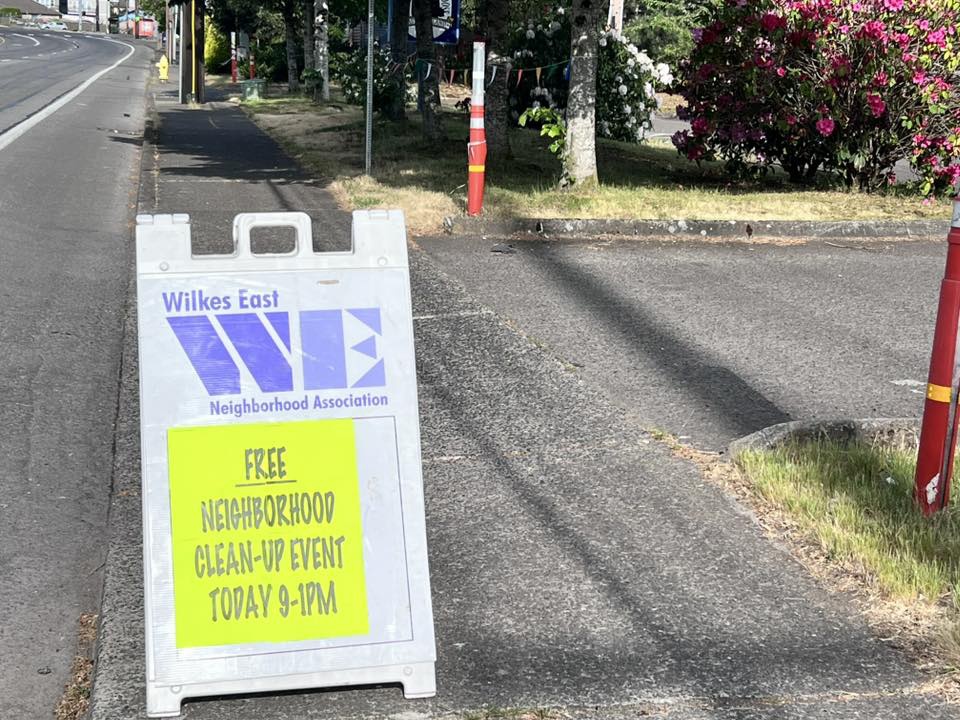 Neighborhood Cleanup Event (Click to enlarge) |
Wilkes East Neighborhood
|
By Greg Hartung, WENA Board Member
Wilkes East Neighborhood Cleanup event was held on May 10th 2025 at the Moose Lodge. The day marked the much-anticipated neighborhood cleanup, an event that—thanks to the collective effort of residents, local organizations, and Metro officials—would become a resounding success, leaving a lasting impact on our community’s environment and spirit.
Every great accomplishment is rooted in thoughtful preparation, and this year’s cleanup was no exception. Planning began months in advance. Flyers were hand delivered to residents, newsletters detailed the event’s objectives: to have a place to bring bulky waste that normally would not have been able to place in a garbage can. The event was free to all to help all residents clear their yards, homes, and garages of no longer needed trash. Donations were collected to help offset the expenses.
The planning committee—comprised of residents young and old, representatives from the neighborhood association, Moose Lodge, Metro, and Waste Management. Metro provided grant money for the dumpsters. The Moose Lodge provided the location and refreshments.
More than 5 tons of bulky waste were collected. Additionally, another 4 tons of scrap metal was diverted to local recyclers.
One of the defining features of the cleanup was the diverse collaboration it fostered. Residents who had rarely exchanged more than a passing wave now worked side by side, sharing stories and laughter as they tackled shared tasks. Yet the true impact of the cleanup reached beyond the day’s visible results. Neighbors, once strangers, now felt a sense of camaraderie forged in shared effort. Throughout the day, conversations among participants revealed a deepened appreciation for both the neighborhood and those who call it home. One resident, originally hesitant to join, was inspired by the sight of so many coming together.
Plans are already underway for next year’s cleanup, with organizers eager to build on this year’s momentum. Suggestions have poured in. If you would like to donate your time and energy for next years plans, you can drop us a line at info@wilkeseastna.org. We welcome ideas and volunteers.
The legacy of this year’s cleanup will live on, not just in the tidy streets and blooming gardens, but in the friendships, goodwill, and renewed sense of belonging it inspired.
Event Photos
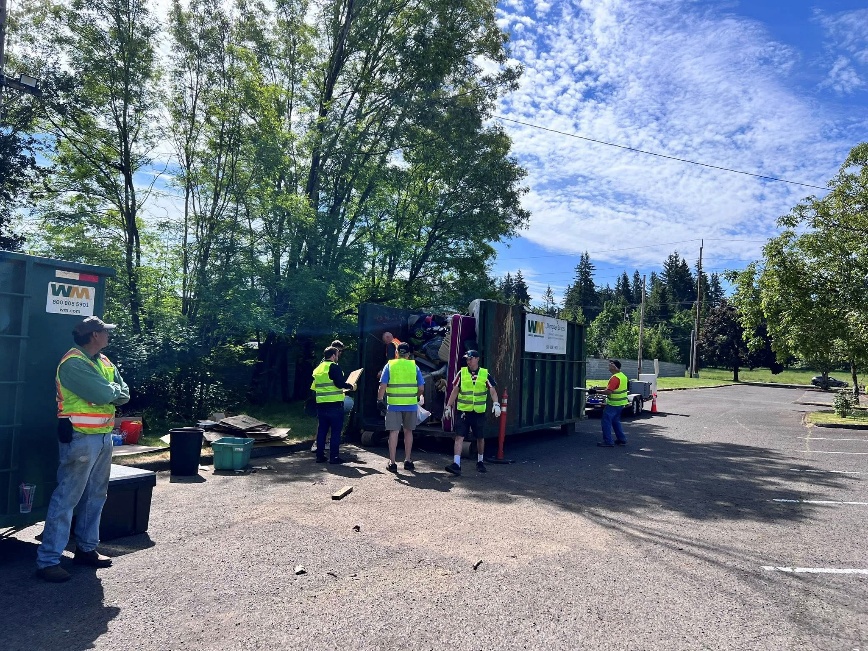 (Click to enlarge) |
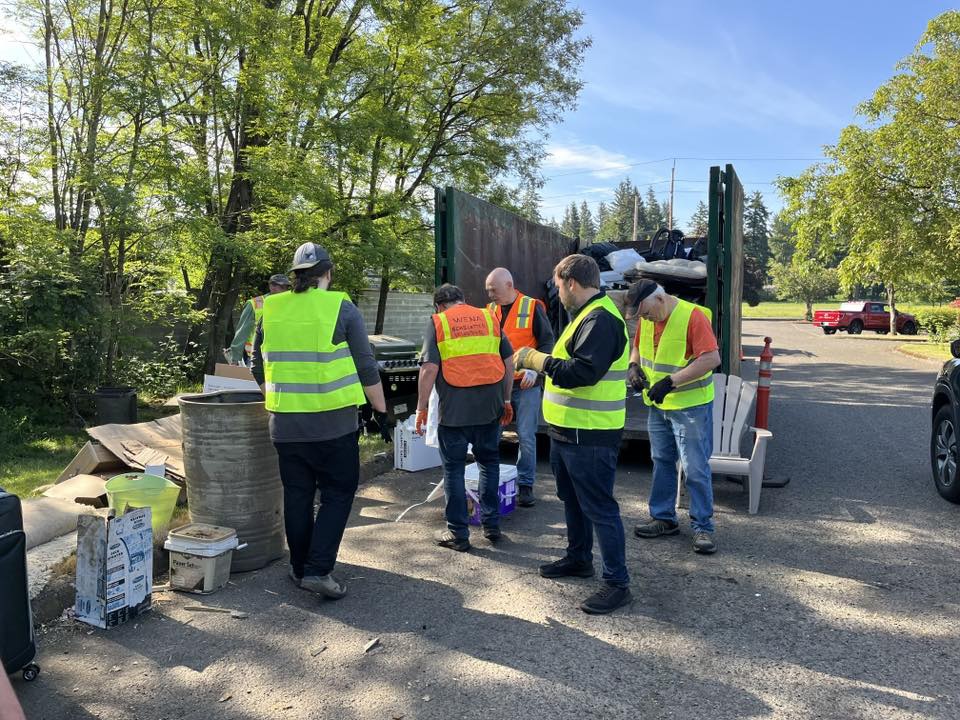 (Click to enlarge) |
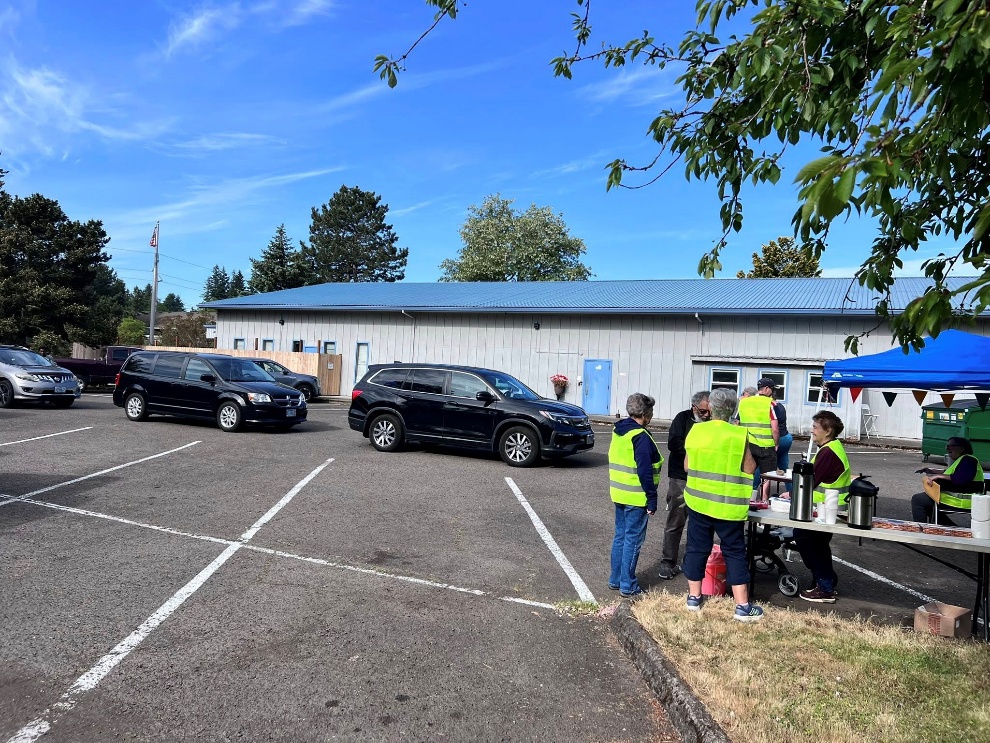 (Click to enlarge) |
||
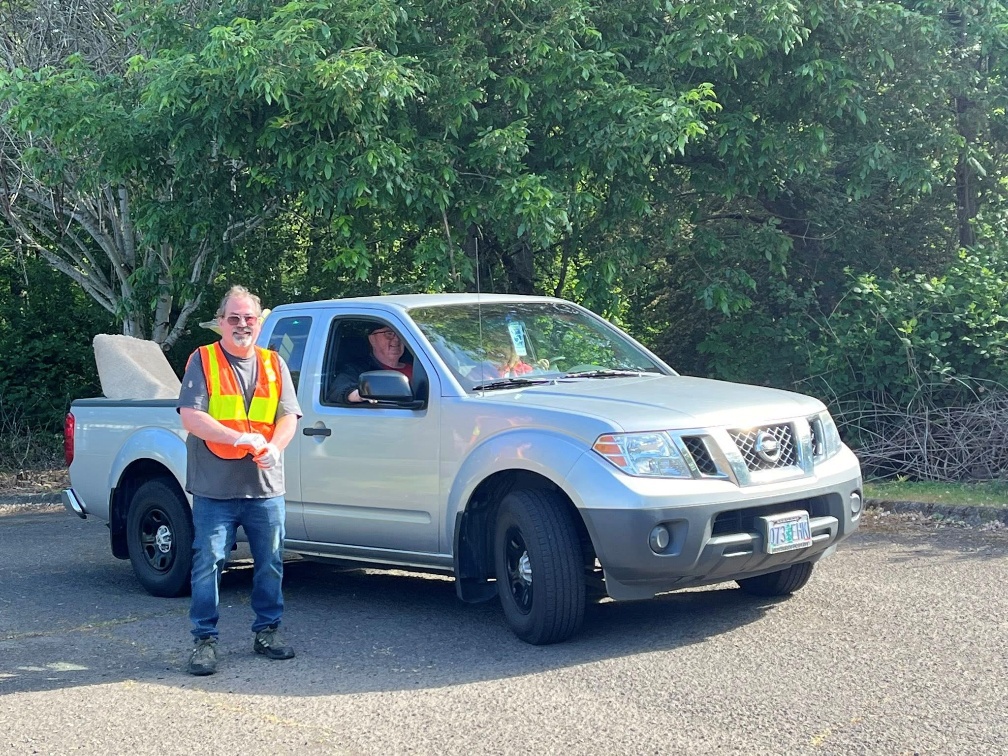 (Click to enlarge) |
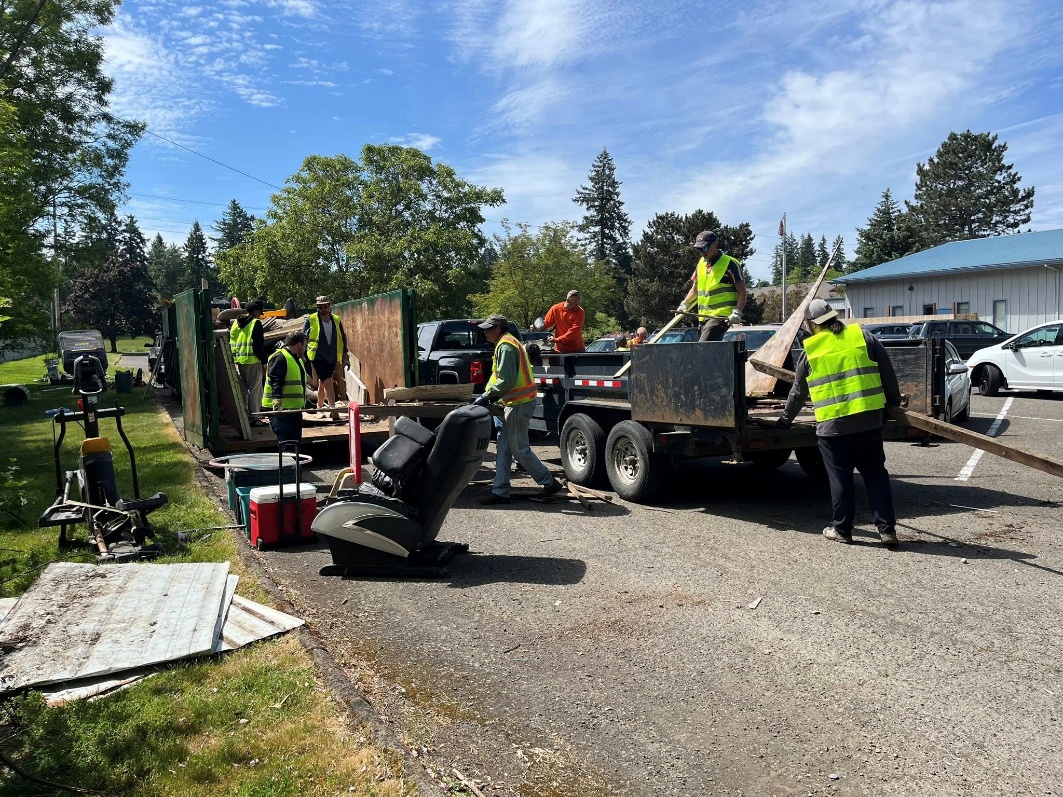 (Click to enlarge) |
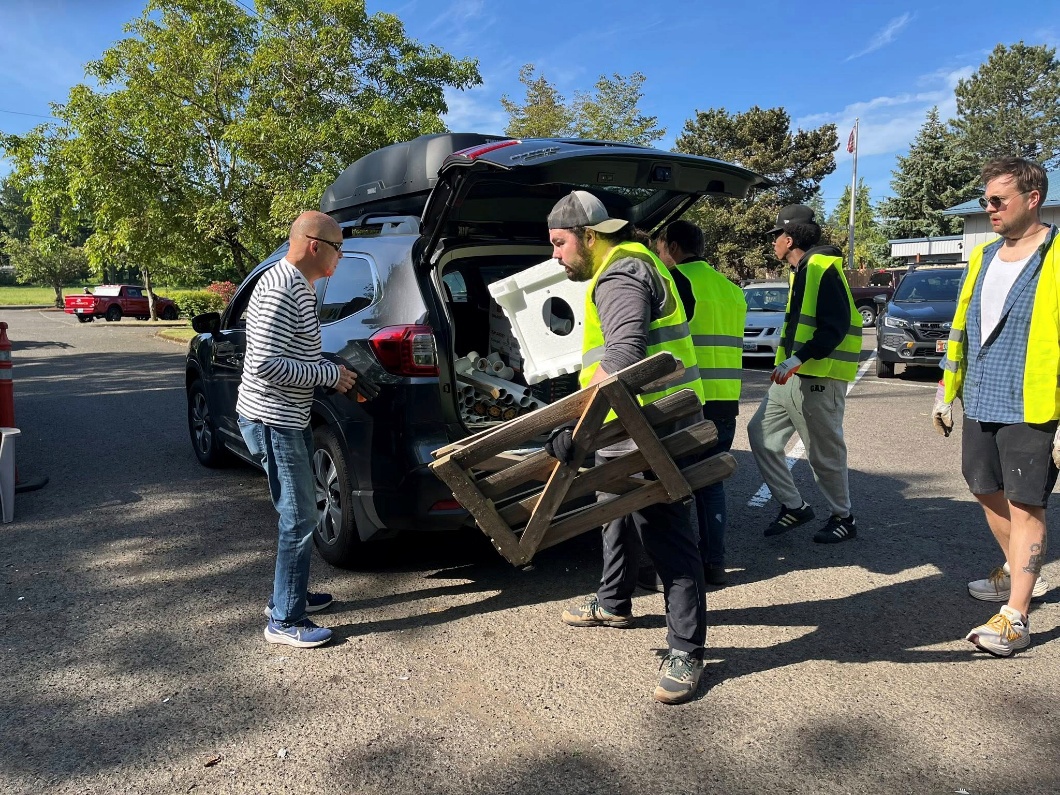 (Click to enlarge) |
The Big, Beautiful Bill and Its Impact on Gresham
By Janet Unruh, WENA Board Member
BIG PICTURE
The One Big, Beautiful Bill Act (BBB) was signed into law by President Trump on July 4, 2025. It covers a wide array of changes to laws, subsidies, and taxes. This article presents facts that have a bearing on how the BBB will affect us in Oregon, Multnomah County, and Gresham. I read parts of the BBB, but relied on articles from respected sources that were written after it became law (see Endnotes). We need to get acquainted with the facts about the BBB and its implications.
Contents
- BIG PICTURE
- THE POOR IN OREGON, MULTNOMAH COUNTY, AND GRESHAM
- CHANGES TO SNAP
- CHANGES TO MEDICAID
- NEW 80-HOUR-PER-MONTH WORK RULES
- MAXIMUM INCOME TO RETAIN BENEFITS
- IF A PARENT MISSES THE 80-HOUR RULE
- WHAT’S THE IMPACT ON KIDS?
- SOME SENIORS MAY HAVE TO GO BACK TO WORK
- THE BURDEN ON OREGON
- IMPOSSIBLE TO IMPLEMENT
- CONCLUSION
(Note: To enable the embedded Endnote[01] links below - click here)
The changes to Medicaid and the Supplemental Nutrition Assistance Program (SNAP) will negatively affect millions of Americans. SNAP will be cut by $230 billion over 10 years, according to the Congressional Budget Office (CBO)—about a 20% reduction. This is the largest cut to SNAP in history. On the national level, it will affect more than 40 million people who receive basic food assistance through SNAP, including 16 million children, 8 million seniors, and 4 million non-elderly adults with disabilities[1][2]. Medicaid will be cut by over $1 trillion over the next 10 years, and changes to federally funded health insurance programs will leave nearly 12 million people without coverage, according to an estimate from the CBO[3][4].
What about the new tax breaks, you may ask? Tax breaks are nice, but most people won’t see the benefit until sometime next year--after they do their taxes. In the meantime, things are changing for the worse. Refunds may come before the midterms—or they may not—depending on whether the IRS’s work is snarled by layoffs[5].
THE POOR IN OREGON, MULTNOMAH COUNTY, AND GRESHAM
Let’s look at the size of the population that will be affected by BBB cuts. It’s possible to find the extent of poverty and financial hardship in Oregon, Multnomah County, and Gresham. What percent of people are living in poverty--the poor? There are recent data from 2023 and 2025. According to 2023 data for the Federal Poverty Level (FPL), 12% of Oregon households were living in poverty[6][7]. However, there are an additional 30% of households in Oregon that are not identified as living in poverty, but nonetheless struggle to pay for utilities or a car repair, and are forced to decide between food or prescriptions[8].
These households are Asset-Limited, Income-Constrained, Employed—“ALICE[9]”—households with working adults whose income is above the poverty level, but who don’t earn enough to afford basic expenses in the county where they live. Between ALICE households and those living in poverty, an estimated 42% of households in Oregon were below the ALICE Threshold in 2023.
Using the ALICE website, we can focus on demographics about poverty in Gresham. Households living below the ALICE threshold in Gresham and nearby areas: 97230, 55%; 97233, 66%; 97236, 56%. 97024, 54%; 97030, 60%; and 97080, 38%[10]. Other data show the demographics of poor families in Gresham as married-couple families (34.6%); male, no wife (11.7%); and female, no husband (53.7%)[11].
There’s still one more data point on poverty. In 2023, 7% of Gresham residents were
living on an income below 50% of the poverty level. In 2025, 100% of the monthly federal poverty level for a three-person household is: $2,221; for a household of four, 2,679; and for five, $3,138[12].
CHANGES TO SNAP
Now, let’s look at the demographics of SNAP beneficiaries in Oregon. SNAP helps approximately 27% of households afford groceries. This includes children, working families, older adults, and people with disabilities. However, even with SNAP benefits, many families struggle to meet their basic needs, especially with the the rising cost of food and housing. The SNAP cutbacks could impact 700,000 Oregonians who depend on the program for food security[13]. In Multnomah County, 142,603 people will be affected[14].
An increasing number of people are turning to food banks for help in Oregon and Southwest Washington. In the past five years, total visits to those food banks increased from about 860,000 to 2.5 million. Unfortunately, the Agriculture Department ended two programs that gave schools and food banks money to buy food from local farms and ranchers, cutting over $1 billion in federal funding[15].
“The [BBB] cuts would make this the single largest rollback of food aid in American history and would hurt Oregonians who rely on SNAP, as well as local farmers and grocers,” said Oregon Representative Andrea Salinas. “The cuts would extend beyond SNAP to threaten food assistance programs like Meals on Wheels[16].”
CHANGES TO MEDICAID
Medicaid in Oregon insures about 33% of the population[17]. In Multnomah County, 35.9% of the population were Medicaid recipients as of May 2025[18]. I didn’t find information specifically about Medicaid recipients in Gresham.
Medicaid covers services for about half of all births, long-term health needs, and people with disabilities. Medicaid supports hospitals, clinics, and health care providers. Under the BBB, 100,000 Oregonians could lose Medicaid coverage (some estimates are as high as 200,000), according to Emma Sandoe, Medicaid Director of the Oregon Health Authority. The bill could lead to at least $1 billion in Medicaid cuts to Oregon between 2027 and 2029[19].
NEW 80-HOUR-PER-MONTH WORK RULES
New rules require individuals and parents to work 80 hours per month, with few exceptions. Previously, for SNAP, parents whose children were younger than 18 were not required to work. The age has now been lowered to 7. Age 7 is when children begin first grade, so the new rule apparently assumes that parents can find work that fits the school schedule. The rules have changed for Medicaid eligibility, too. Everyone who receives Medicaid benefits must now work 80 hours per month—this is new. Both requirements begin at the end of next year, on December 31, 2026[20]. Pregnant women, people with serious medical conditions, tribal members, and parents or caregivers of a dependent child aged 13 or younger—or with a disability—are exempt from the 80-hour work rule[21].
To satisfy the work requirements, recipients must work at least 80 hours per month at a job, volunteer for an approved agency, participate in a work program, or take part in an educational program, unless they’re exempt [22][23].
In Gresham, nearly 70% of the adults in poor, married-couple families work full- or part-time (not shown, whether they have children). Here’s a breakdown of work status for poor families: Both adults work full-time—2%. One works full-time and the other part-time—2%. One works full-time; the other doesn’t work—8.9%. Both works part-time—15.7%. One works part-time; the other doesn’t work—41.3%. Neither adult works—30.1%. Cases where one or both adults are not currently working will be affected by the new work requirements. This amounts to 71.4% of poor married-couple families in Gresham with or without children. Of poor residents “not in families,” 4.5% worked full-time, year-round; 27.7% worked part-time; and 67.8% didn’t work[24]. This last group will have to find a minimum of 80 hours of work per month.
What is the outlook for finding a job that can reliably provide 80 hours of work? As it stands, it’s a challenge. In a June 10, 2025, national Gallup survey of U.S. workers, 27% said they face schedule unpredictability, 28% said they may have more or fewer hours, and 41% said they have little or no control over their work schedules[25].
For some people, a gig like Uber or Lyft might work because drivers get paid for the time spent giving people a ride (plus some extras), but time spent driving without passengers or waiting doesn’t count. Also, the car has to be very nice and spotless. Delivery gigs like DoorDash don’t pay by the hour, so they wouldn’t qualify for the 80-hour-per-month requirement.
Let’s take the example of a family with two parents and several kids. We’ll say that the father can meet the 80-hour-per-month requirement because he works part-time in a restaurant during the day. The mother, however, may try to find some kind of employment that allows her to work between the time she sees the kids off at the school bus stop and picks them up after school. In theory, this would give her four hours per day, five days per week, which would add up to 80 hours per month. But it won’t work during school holidays or summer when kids are out of school. It also doesn’t work if someone in the family is sick and needs to be taken to the doctor, or if the car has to be taken to the repair shop.
To meet the 80-hour-per-month requirement, one of the parents might have to work during the day and the other in the evening or at night. I once read a story about a single mom who worked a graveyard shift (11 PM to 7 AM) so she could pay the bills and take care of her kids. After she got off from work at 7 AM, she would come home in the morning, get the kids fed and off to school, rest for a few hours, pick them up after school, make dinner, help them with homework, put them to bed, and then go back to work at 11 PM. This is obviously a brutal schedule, and it could easily fall apart.
In some families, another relative may be able to help out. But the BBB legislation raises the age limit for work requirements for SNAP benefits eligibility from 55 to 64[26]. So, for example, if Grandma is 61, she will now have to work 80 hours per month, too--unless she can get a caregiver exemption. The bigger issue is, of course, where a good portion of Oregon’s 1,119,407 Medicaid recipients[27] and the 774,581 SNAP recipients[28] will find work, volunteer opportunities, or part-time courses.
MAXIMUM INCOME TO RETAIN BENEFITS
Families must also not exceed the maximum income limits to qualify for benefits. If their income rises above the ceiling, they can lose their benefits.
To be eligible for Medicaid, the family income must be less than 138% of the federal poverty level. For a family of five, the monthly income limit is $4,329.75 or less[29].
For SNAP, the household must meet both gross and net income limits. Net income is what is left after deductions such as standard deductions, dependent care costs when needed for work, training, or education; or medical expenses for elderly or disabled members. For a family of five, the maximum gross monthly income is $3,963, and the net amount is $3,049[30].
One parent working at the minimum wage of $16.30 per hour in the Portland Metro area, part-time for 80 hours per month, would earn $1,304 per month. Two parents would earn $2,608 per month. If the family of five qualifies, they may receive $1,158 in SNAP benefits. Part-time, minimum-wage jobs would fulfill the 80-hour requirement, and keep earners below the maximum income threshold.
If an employee’s income exceeds the maximum limits for Medicaid, chances are that they won’t have health insurance at all. Employers aren’t required to provide health insurance to anyone working less than 30 hours per week or 130 hours per month[31]. Employees may be able to find health insurance through the Affordable Care Act (ACA), but they must estimate their annual income--and they risk having problems if they earn more or less than they anticipated.
IF A PARENT MISSES THE 80-HOUR RULE
The new BBB rules make it more likely that Medicaid and SNAP recipients will lose their benefits. I searched all over and was only able to find this information using ChatGPT-4o, which is reputed to be 88.7% accurate[32], but it may be helpful to some degree. I asked this question: What if one parent can’t get 80 hours of work one month?
If one parent misses the 80-hour requirement, he or she loses Medicaid and SNAP benefits. The other parent and the children continue to be covered by Medicaid and receive SNAP food stamps, but they have less money for groceries because one parent is cut off from SNAP benefits.
What if the parent who didn't have 80 hours one month, then meets the 80-hour requirement the next month—could they get back on Medicaid and SNAP? Yes, if they can prove they now meet the 80-hour requirement, they may requalify for Medicaid. But they must reapply, or go through a reverification process, which can take weeks or even months. They will be uninsured while waiting for approval. SNAP rules allow for assistance once the parent meets the 80 hours again, or if good cause or exemption is documented. They must prove the hours, go through a reapplication process, and often wait a full month for benefits to restart.
Besides the 80-hour rule, there’s a new requirement of more-frequent eligibility checks, which is a review of recipients’ income and work verification. Oregon will have to conduct eligibility reviews every six months, instead of every two years as is done now. Oregon has had less-frequent reviews to reduce on-and-off eligibility, which is referred to as “churn[33][34].” Churn causes people to lose coverage because of paperwork issues rather than ineligibility[35].
WHAT’S THE IMPACT ON KIDS?
The Congressional Budget Office (CBO) estimates that the work requirement would cut SNAP by $92 billion through 2034 and take food assistance away entirely from 3.2 million adults in a typical month, including 800,000 parents of school-aged children. When these adults are cut off from SNAP, their entire households receive less in food benefits. Roughly 1 million children would see their food benefits cut substantially as a result[36].
When kids are enrolled in SNAP, they automatically qualify for free breakfast and lunch at school. And when a high number of kids are enrolled in SNAP, it’s more financially viable for schools to provide free meals to all students. If families fall off the SNAP rolls, fewer kids will qualify for free school meals, schools will get a lower reimbursement from the federal government, and this will make it harder to cover the cost of providing free meals to all kids.
A study by the Urban Institute estimated that the House bill’s cuts to SNAP would put at least 18 million students at risk of losing access to their school's or state’s free school meal program, in part because parents will need to fill out applications. This may come as a surprise because, in the past, when universal free meal programs were available, this wasn’t required[37].
The free school lunch program was also attacked in the Oregon legislature. Oregon lawmakers failed to pass legislation that would have required all 197 school districts to provide free breakfast and lunch for all students[38].
Other programs are tied to SNAP and Medicaid eligibility. The loss of those benefits often leads to the loss of related support. Besides losing school meals, one cutoff can cause a family to lose many other critical supports, such as help with utilities, housing aid, or internet subsidies, because they rely on “core program” eligibility[39].
Besides these losses due to attrition, another kind of funding cut has to do with the Thrifty Food Plan (TFP) limits. The USDA created the TFP to be a food cost index that is used to determine maximum monthly benefits for SNAP. It accounts for food price inflation based on a market basket of goods (healthy, low-cost foods) for a family of four, which is recalculated each year.
Section 10001 of the BBB prevents updates to the cost of the TFP based on a reevaluation of the market basket and instead, ties it to the Consumer Price Index. Further, the reevaluation may not occur more frequently than every five years[40][41][42]. This restriction will prevent SNAP benefits from keeping up with rising food costs, eroding families’ purchasing power over time and increasing hardship for recipients.
Cuts to Medicaid affect schools, too. In March, a group of education associations surveyed 1,400 school staffers and officials from across the U.S. about how they rely on Medicaid. Around 9 in 10 respondents said they used Medicaid to pay the salaries of school health staff, such as school nurses, psychologists, and speech therapists. A little under half relied on Medicaid to buy assistive technology and other specialized equipment for students with disabilities. Cuts to Medicaid would likely require schools to lay off staff and make cuts elsewhere in their budgets, the survey found[43].
SOME SENIORS MAY HAVE TO GO BACK TO WORK
Medicaid recipients aged 19 to 64, including those who received coverage through the ACA expansion of Medicaid, are now required to work at least 80 hours per month[44]. This is new. Millions who were previously on Medicaid—especially adults who provide full-time care for others or who have unstable schedules—will now be subject to this requirement. For SNAP, as mentioned above, the BBB raises the age limit for work requirements from 55 to 64[45]. So, there may be some seniors who have to go back to work until they’re 65.
Seniors aged 65 and over can claim a $6,000 tax deduction (per person) on top of the standard deduction for tax years 2025 through 2028. This applies to incomes up to $75,000 (single) or $150,000 (married jointly) and phases out above those limits[46].
While seniors will receive some tax breaks, the BBB cuts Medicaid and SNAP—programs that many older adults also rely on for long-term care, medications, and food assistance.
BURDEN ON OREGON
The BBB puts a heavy burden on Oregon to accommodate the changes. The state must figure out how to apply the new rules and manage the cascading effects of cuts to Medicaid and SNAP on other programs. Oregon must also update or build new computer systems and establish new institutional processes. Most concerning of all, the state will be forced to distribute less funding to people who need it most.
MEDICAID
Federal cutbacks will limit the number of people who can access Medicaid. As many as 200,000 Oregonians could lose Medicaid coverage due to the new requirements. State health officials say the resulting decline in Medicaid enrollment will lead to a significant loss of federal funding for Oregon. The Oregon Health Authority estimates that the state could lose up to $1.4 billion per year—or as much as $16 billion over 10 years[47].
The BBB imposes new restrictions on local provider taxes that states use to fund their Medicaid programs. This could cost Oregon an estimated $11.7 billion in lost federal matching funds and state revenue over 10 years[48].
More frequent eligibility checks will require significant investment in updating computer systems and hiring more administrators, potentially costing the state hundreds of millions of dollars. This will cost more than $100 million for the state to implement[49]. State Medicaid Director Emma Sandoe told state legislators that she would need to hire between 800 and 1,200 additional eligibility workers to handle the more frequent reviews required by the bill[50]. The requirement for six-month eligibility checks takes effect on Dec. 31, 2026, although the Health and Human Services Secretary can delay implementation until the end of 2028[51].
Also, for Medicaid, the BBB requires states to implement cross-state Social Security number matching and quarterly death database checks to verify eligibility[52]. I wasn’t able to find a cost estimate for that, but an 11-year project to standardize Medicare and Medicaid computer systems that ended in 2018 cost states $44.1 billion. Unfortunately, the results were unsuccessful. The Centers for Medicare and Medicaid Services (CMS) reimbursed the states $34.3 billion of that amount, and states were responsible for the remaining $9.8 billion[53].
The BBB also limits federal funding for emergency care for undocumented immigrants in Oregon by reducing the Federal Medical Assistance Percentage (FMAP) from 100% to 60%. This means Oregon must now pay 40% of emergency care provided to undocumented immigrants. The total cost is estimated at $5 billion over the next 10 years[54][55].
SNAP
Currently, the federal government funds the full cost of SNAP benefits. Starting in October 2027, Oregon may be required to pay as much as 25% of its SNAP costs[56], or $425 million per year[57]. This amount could be reduced if Oregon can bring down its payment-error rate.
In March 2025, Oregon was notified of a $15.7 million penalty for exceeding the national average SNAP payment error rate for two consecutive years. The state's error rate peaked at 22.99% in 2022 but has since improved to 13.4% in 2025. Officials emphasized that these errors are not indicative of fraud, but rather reflect systemic challenges in eligibility and benefit calculations. To address these issues, Oregon has opted for a settlement option that allocates $7.8 million toward corrective actions and reserves the remaining funds for future liabilities[58]. Implementation is delayed to fiscal year 2029 or 2030 for states with high payment error rates[59].
And that’s not all. States will be responsible for 75% of the SNAP administrative costs, up from 50%[60]. Oregon would have to come up with an additional $76.3 million, for a total of $160.1 million, to maintain program operations[61].
IMPOSSIBLE TO IMPLEMENT
The BBB will cause both federal and state governments to scramble to update or create new computer systems and departmental workflow processes.
Take this, for example: states are being asked to coordinate with each other to cross-check Social Security number matching and quarterly death data to verify eligibility for Medicaid[62]. If it goes anything like the Centers for Medicare and Medicaid Services (CMS) project[63] (mentioned earlier in this article) to gain oversight of states’ use of federal funds for Medicaid computer systems, success seems unlikely. States were using different computer systems, which made data sharing next to impossible. In some cases, states’ systems lacked the necessary data, and funding requests were rejected for lack of supporting documentation. There were duplicated efforts, stakeholders left out, miscommunication, a lack of oversight, and multiple failed initiatives. In the end, the project was never completed.
Oregon does not have a good track record with upgrading its computer systems, either. The state spent $300 million to develop its own online healthcare marketplace, but ultimately abandoned the project. Since then, the state has begun using a “painstaking process” to ensure the success of its projects, but it has slowed down completion to the point of taking years to get anything done.
Oregon’s Employment Department will likely play a role in tracking the 80-hour-per-month work requirement. However, the department is bedeviled by legacy computer systems failures, dysfunction, and management turnover. Before the passage of the BBB, the department was planning to select a vendor to build a new computer system by the end of 2025, but that effort is on hold, and there are issues with managing the project’s budget[64]. The kind of upgrades that Oregon’s computer systems would need to handle the BBB requirements would truly be massive.
Let’s review the deadlines. By December 31, 2026, Medicaid and SNAP work requirements go into effect, and the six-month Medicaid eligibility reviews begin. Implementation requirements for Medicaid’s 80-hour-per-month work rules are due to be published by Health and Human Services (HHS) on June 1, 2026[65]. I didn’t find implementation requirements for SNAP. In 2028 and beyond, states begin paying a larger share of SNAP costs. These deadlines are impossible.
How will these changes be paid for? I read that the BBB legislation provides $200 million for HHS implementation funding at the federal level, and $200 million for states in FY2026[66]. Was that supposed to mean that each state would receive $200 million? I searched the internet, but only ChatGPT had an answer: the $200 million total is to be divided among all 50 states and territories, averaging just $4 million per state. ChatGPT said, “that number is, frankly, wildly inadequate.”
The BBB also provides $15 million in 2026 for implementation of changes to states’ computer systems to support Medicaid cost-sharing requirements, which will apply to some individuals. In some cases, this could mean up to $35 per service[67]. Again, ChatGPT explained that the $15 million is to be split among the 50 states and the territories, and they’ll receive it as a one-time funding. Oregon, for example, might receive $1–2 million at most. Besides the legislation that allots this funding specifically for Medicaid cost-sharing, I found no other federal funding for Medicaid or SNAP.
The changes to Medicaid and SNAP will be hitting after the midterms, but if US citizens are informed, a turnover in Congress is likely, which may result in attempts to repeal the BBB. Will there be an avalanche of lawsuits? Probably. And what if states don’t or can’t comply with the new rules—will the Trump administration punish them in some way? Would he—could he—cut off federal funding altogether?
CONCLUSION
Millions of people in this country live in poverty. Stripping away their food, health care, and other survival benefits will lead to a precipitous disaster. As detailed earlier in this article, 42% of households in Oregon struggle to pay for necessities, 27% rely on SNAP to help buy groceries, and 33% of the population in Oregon is insured by Medicaid—35.9% in Multnomah County. The BBB threatens to push these people to the breaking point—if it can be implemented at all.
We need local governments to begin sorting out the facts and implications of the BBB, and to start working on solutions. We’d better not sleepwalk into this disaster. Time is short.
Click "Read more" (below) to view Endnotes
Wilkes East Land Use Update, Summer 2025

by Greg Hartung, WENA Land Use
Hello members of our Wilkes East Neighborhood Association.
The Wilkes East Neighborhood Association board regularly receives land use plans from the City of Gresham to notify us of land use projects within or proximity to the Wilkes East neighborhood boundaries.
DR-24-00679 Location: Pape Properties 17217 NE Sandy Blvd. Ditch Witch Outdoor Storage and lot line adjustment. The proposal involves the additional 49,000 square feet of outside graveled storage yard to be used by Ditch Witch for outdoor storage of equipment and a separate lot to the east for future development. No new buildings are proposed at this time.
PRE-25-00061 Location: 17905 NE Glisan St. This is a pre-application for consideration of food cart pod for 18 carts, 40 x 80 indoor seating area: retaining the existing house. Narrative: “The lot contains approximately 0.63 acres and is relatively flat with an elevation of approximately 251 feet near the south line adjacent to NE Glisan Street. The owner wants to develop the site with 18 food carts and a 3200 square foot covered dining area in the center as shown on the Preliminary Site Plan included. The project also includes 9 parking spaces within a parking lot, the required utilities, including stormwater management, will be part of the project. The driveway accesses to NE Glisan Street and is 20 feet wide”.
For these and other public records, you can visit this web link: https://greshamor-energovweb.tylerhost.net
You do not need to create or register an account with online services to access project files. To search for project files and public records:
- Click on the search icon.
- n the screen that loads, type in the Plan case number in the search field and click on the search button.
- The page will reload with the results of the search, including highlighted direct links to cases.
- Click on the highlighted link for the Plan case.
- In the page that loads, click on the Attachments tab to view project files.
You can also view detailed instructions on how to search for public records. Website: https://greshamoregon.gov/workarea/DownloadAsset.aspx?id=13448
If you have any questions about accessing the files online or any projects, please contact PlanningTech@GreshamOregon.gov


